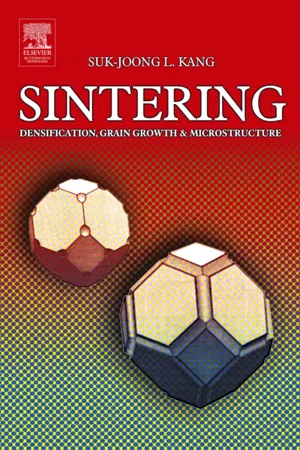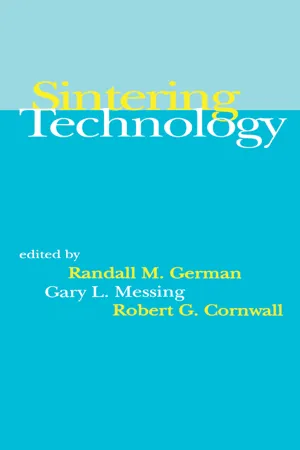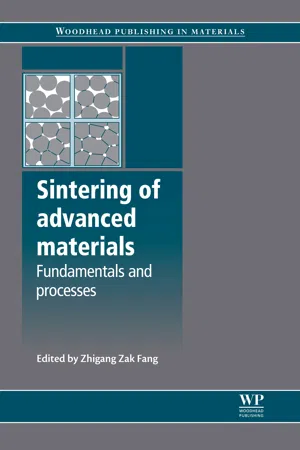Technology & Engineering
Grain Growth
Grain growth refers to the process by which the grains in a material increase in size over time. This phenomenon occurs in materials such as metals and ceramics, and it can affect the mechanical and physical properties of the material. Grain growth is influenced by factors such as temperature, time, and the presence of impurities or other defects in the material.
Written by Perlego with AI-assistance
Related key terms
Related key terms
1 of 4
Related key terms
1 of 3
3 Key excerpts on "Grain Growth"
- eBook - ePub
Sintering
Densification, Grain Growth and Microstructure
- Suk-Joong L. Kang(Author)
- 2004(Publication Date)
- Butterworth-Heinemann(Publisher)
Figure 9.1 shows an example of the microstructure of abnormal Grain Growth. There are several grains whose size is a few tens and hundreds of times that of the fine matrix grains. Such an abnormal Grain Growth is observed not only in single-phase systems but also in multi-phase systems. For a single-phase system without a liquid, the classical explanation of abnormal Grain Growth concerns non-uniform distribution of second-phase particles or solutes. Under the non-uniform distribution, normal Grain Growth may locally be suppressed and abnormal grains may form. The presence of a few large grains in a matrix of fine grains was also suggested to be a cause of abnormal Grain Growth.In reality, however, a number of different examples are available and these may be categorized into three types:Figure 9.1 Typical microstructure of abnormal Grain Growth in 0.1 mol% TiO2 -excess BaTiO3 sintered at 1250°C for 24 h in air.(i) materials containing second-phase precipitates or impurities of high concentrations, (ii) materials with a high anisotropy in interfacial energy, for example, solid/liquid interfacial energy or grain boundary energy in the bulk and surface energy in thin films, and (iii) materials in high chemical inequilibrium.For any case, abnormal Grain Growth is a result of very high local rates of interface migration. A basic understanding of abnormal Grain Growth is just at its beginning. A number of computer simulations86 -91have been made but theoretical analyses appear incomplete as yet.9.1 PHENOMENOLOGICAL THEORY OF ABNORMAL Grain Growth IN SINGLE-PHASE SYSTEMS
Phenomenologically, abnormal Grain Growth is characterized by fast growth of a few large grains in a matrix of fine grains of which the size change with annealing time is almost nil or at least negligible compared with that of the abnormal grains. Under this condition, the growth rate of the abnormal grains, dGa/dt , is expressed as4(9.2)=dG ad tD b ⊥R T2γ bβG ¯mV mω(9.2)whereGm - eBook - ePub
- GerMan/Messing/(Author)
- 2020(Publication Date)
- CRC Press(Publisher)
1. Introduction
Many physical properties of polycrystalline materials are microstructure-dependent. Grain size is often the most important characteristic parameter in microstructure analysis. Mean grain size increases by growing of large grains at the expense of small grains.From the earliest treatment of Beck, et al. (1948), it has been supposed that the Grain Growth obey exponential kinetics in a general form asD n-D o n=Kt(1) where D is the mean grain size at time t, D0 mean initial grain size t = 0, and K a constant. Assuming that the initial grain size is negligibly small compared to the grain size at time t, the equation (1) can be written as
here n is termed Grain Growth exponent. For the parabolic law, n = 2.D n= Kt(2) Although many experimental data on the Grain Growth exponent have been set forth, the values vary from n = 2 to n = 4 even in the zone-refined ultrapure metals (Atkinson, 1988). Vandermeer and Hu (1994) reanalyzed Grain Growth data on zone-refined iron previously made by Hu (1974) taking into account the initial grain size. They claimed that neglecting D0 can cause wrong value for n.For the growth kinetics analysis to be accurate two prerequisite conditions should be satisfied: one is uniform appearance in grain shapes, and the other is statistical self-similarity during growth (Atkinson, 1988). These two conditions are very crucial for proper interpretation. Moreover, the proportionality constant for the relation of measured feature size on the metallographic surfaces and real spacial size is known to vary with grain shapes and grain size distributions (Han and Kim, 1995) (Louis and Gokhale, 1995). Thus, topological steady-state distribution must be proved to find out accurate value for Grain Growth exponent.The aim of the present study is to simulate Grain Growth during transient period in a two-dimensional model by Monte Carlo technique and to study the effect of initial grain size distribution on Grain Growth.2. Monte Carlo Simulation Procedure
- eBook - ePub
- Zhigang Zak Fang(Author)
- 2010(Publication Date)
- Woodhead Publishing(Publisher)
86 It appears that a critical temperature exists, above which the Grain Growth accelerates dramatically as a function of temperature.17.14 Grain size vs. temperature during heating up of nanocrystalline WC-Co powder at a heating rate of 10 °C/min.The issue of Grain Growth during sintering can be studied by examining the grain size versus relative density relationship. This approach has been applied to the study of sintering of nano particles. A typical relationship between grain size and density during sintering of nano particles is schematically shown in Fig. 17.15 . In one of the earliest studies of the sintering and Grain Growth of nanosized ceramic powders in the 1990s, Owen and Chokshi87 and Averback et al.88 showed that oxides densify without significant Grain Growth until the density reaches approximately 90% of the bulk density. Then the Grain Growth becomes very rapid. This phenomenon is observed in many different materials.2 , 3 , 89 , 90 This relationship implies that the Grain Growth during sintering consists of two stages: the early stages of sintering, before the powder compact reaches 90% relative density; and the late stages of sintering, when relative density is greater than 90%. It is believed that the late stages of Grain Growth can be viewed as ‘normal ’ Grain Growth, similar to that found in bulk materials by boundary migration, but incorporating the effect of pinning by closed pores. In contrast, the early stage of Grain Growth during sintering is often referred to as ‘coarsening
Index pages curate the most relevant extracts from our library of academic textbooks. They’ve been created using an in-house natural language model (NLM), each adding context and meaning to key research topics.
Explore more topic indexes
Explore more topic indexes
1 of 6
Explore more topic indexes
1 of 4


